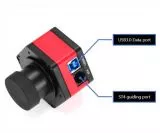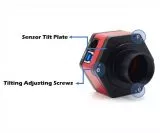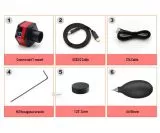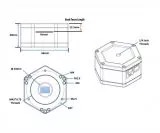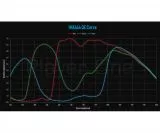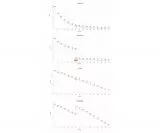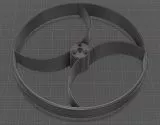- Details
- More images
Products description
TS-Optics Neptune 664C color astro camera, Sony IMX664 sensor D=9.02 mm
The Neptune 664C camera offers a very high resolution and can be used for lunar and planetary photography, EAA and also for deep sky astrophotography.TS Neptune 664C color astro camera, Sony IMX664 sensor D=9.02 mm
The Neptune 664C is a camera that uses the Sony IMX664 sensor in 1/1.8? format. The pixel size of 2.9 µm enables a full-well capacity of 38.5 ke with a total of 4.2 MP. The resolution is 2704 × 1540 pixels and the diagonal is 9.02 mm.Super AR Plus window
The PO664C is using a Super AR Plus coated protective window. This guarantees super high transmittance from 310 nm to 1100 nm and improves the performance in both Ultraviolet and N.
STARVIS 2 Technology
The PO664C is based on the Sony STARVIS 2 technology with a back-illuminated CMOS image sensor.
Non-Amp-Glow
Non-Amp-Glow can give us very clean background, so it is much easier to get high quaility images.
Sensor Tilt Plate
The built-in high-density sponge shading pad blocks the light from the side without any leakage. When taking solar photograph with prominence telescope, Newton rings are annoying. The tilt plate helps avoiding this phenomenon.
256M DDR3 Cache
Player One Astronomy cameras are the first that adpot the DDR3 cache in all planetary cameras. DDR3 cache stabilizes data transmission, and effectively avoids frame dropping and greatly reduces read noise.
With the DDR3 cache, the camera does not have high demands on computing power any longer, it will still have excellent performance even if it is connected to a USB 2.0 port.
DPS technology
The planetary cameras from Player One Astronomy are equipped with the DPS (Dead Pixel Suppression) technology. The DPS analyses dark frames to find dead pixels and records the map in camera memory. During imaging, each frame, each frame is filtered to remove dead pixels.
Overvoltage and overcurrent protection mechanism
The safety of your camera and other equipment is maintained through overvoltage and overcurrent protection mechanisms.
Data Port
When the camera is connected to the USB 3.0 interface and the full-resolution preview is used, it can reach 107 FPS in RAW8 mode (10bit ADC). When recording images, since the actual writing speed will be affected by the writing speed of the hard disk itself, when the hard disk writing speed is slow, the recording may not reach the theoretical speed. It is recommended to use a high-quality solid state drive to record data to give full play to the performance of the camera.
Use the ST4 guide cable to connect the camera to the corresponding port of your mount to do guiding.
Readout Noise
The readout noise valueas were obtained from actual tests.You can use Sharpcap 4 for testing. SC4 has a function called Sensor Analysis, providing a very simple way to test readout noise.
| Sensor: | SONY IMX664 1/1.8" CMOS (color) |
| Diagonal: | 9 mm |
| Total Pixels: | 4.2 Mega Pixels |
| Max Resolution: | 2704 × 1540 |
| Pixel Size: | 2.9 µm |
| Chip Size: | 7.8 mm × 4.5 mm |
| Frame Rate: | 136 FPS (10 bit) |
| Bayer Matrix: | RGGB |
| Shutter: | Rolling shutter |
| Exposure Range: | 32 µs-2000 s |
| Readout Noise: | 6.1 - 0.67 e |
| QE Peak: | 91 % |
| Full well capacity: | 38.5 ke |
| ADC: | 12 bit |
| Data Port: | USB 3.0 / USB 2.0 |
| Adapter: | 1.25" / M42 X 0.75 |
| Back Focal Length: | 12.5 mm |
| Protective Window: | High Quality Anti Reflection Multi-Layer Coating |
| Diameter: | 66 mm |
| Weight: | 180 g |
| Resolution (USB3.0 mode) 12 bit: | 2704×1540 46.5 FPS / 2560×1440 52.5 FPS / 1920×1080 93 FPS / 1280×720 203 FPS / 800×600 240 FPS / 640×480 294 FPS |
| Resolution (USB3.0 mode) 10 bit ADC: | 2704×1540 93 / 2560×1440 105 FPS / 1920×1080 187 FPS / 1280×720 275 FPS / 800×600 325 FPS / 640×480 398 FPS; More resolution options can be setup in the capture software. |
Camera
1.25" adapter and cover
Air blower
USB 3 cable
ST4 cable
2 mm hexagon wrench
EN- Safety instructions
Not suitable for children under 3 years of age.
Packaging not suitable for consumption.
Keep packaging out of reach of children. Risk of suffocation!
Never look at the sun with a telescope or binoculars. Risk of blindness!
Children should only use telescopes and binoculars in the presence of an adult.
This Product was added to our catalogue on 05/05/2025.
Categories
Quick purchase
Welcome back!
Last viewed:
Manufacturer
Shipping country

